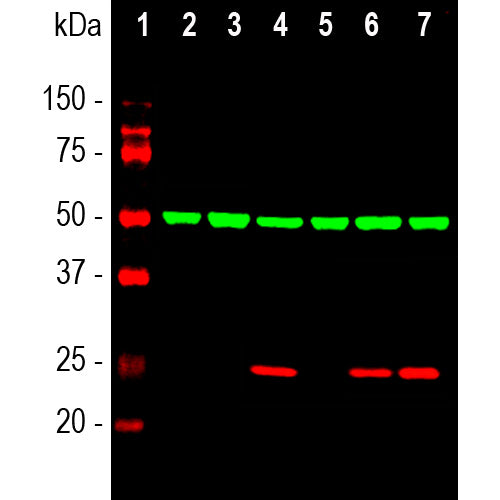

EnCor Biotechnology
Chicken Polyclonal Antibody to Heat Shock Protein 27 (HSP27), Cat# CPCA-HSP27
Description
The CPCA-HSP27 antibody was made against full length recombinant HSP27 expressed in and purified from E. coli. This antibody binds to human protein but not the the rat and mouse homologues on western blots. It can be used in IF and ICC. We document that the antibody works well not only for western blotting, IF and ICC but also on formalin fixed paraffin embedded sections, select the "Additional Data" for this data. We also supply a mouse monoclonal antibody to HSP27, MCA-6H11, specific for the human protein but not recognizing rodent HSP27, which can therefore be used to identify human cells in a rodent background.
Add a short description for this tabbed section
| Name: | HSP27, chicken polyclonal, Cat# CPCA-HSP27 |
| Immunogen: | Recombinant full length human HSP27 expressed in and purified from E. coli |
| HGNC Name: | HSBP1 |
| UniProt: | P04792 |
| Molecular Weight: | 27kDa |
| Host: | Chicken |
| Species Cross-Reactivity: | Human, unreactive with rodent |
| RRID: | AB_2572328 |
| Format: | Concentrated IgY preparation plus 0.02% NaN3 |
| Applications: | WB, IF/ICC, IHC |
| Recommended Dilutions: | WB: 1:2,000-5,000. IF/ICC 1:1,000. IHC: 1:5,000-1:10,000. |
| Storage: | Store at 4°C. Stable for 12 months from date of receipt. |
The heat shock proteins were discovered since they are heavily upregulated when cells are stressed by temperatures above the normal physiological range. They are expressed in unstressed cells also and have a normal function as chaperones, helping other proteins to fold correctly, but are required in much greater amounts if the cell or tissue is stressed by heat. Heat shock protein 27 (HSP27) is an abundant protein which functions as a chaperone but has many other functions. Upregulation of this protein is protective against neurodegenerative diseases at least in certain mouse models (1). Point mutations in the HSP27 gene are associated with two neurological diseases, Charcot-Marie-Tooth disease type 2F and distal hereditary motor neuropathy IIB (2). These diseases are associated with axonal loss apparently following defects in the transport of neurofilaments. HSP27 may bind cytoplamsic cytochrome c released from mitochondria which would otherwise normally activate the caspase apoptotic cascade (3). HSP27 is a major phosphoprotein of cells primarily under the influence of the p38/SAP kinase and JNK pathways (e.g. 4). The central region of the HSP27 molecule corresponds to a crystallin domain, a compact module found in many chaperones and heat shock proteins. HSP27 is implicated in several other aspects of cell signaling and response to cancer and other diseases (5-7). The amino acid sequence of HSP27 is relatively poorly conserved across species boundaries, so there are 159 amino acids identities between human, cow, rat and mouse HSP27, out of 204-209 amino acids. This variability results in some antibodies being species specific while others work across many species.

Chromogenic immunostaining of a formalin fixed paraffin embedded section of human pancreas section with chicken pAb to HSP27, CPCA-HSP27, dilution 1:5,000, detected with DAB (brown) following the ABC method with citra buffer retrieval. Hematoxylin (blue) was used as the counterstain. In the pancreas, the HSP27 antibody identifies the ducts and injured pancreatic cells. Mouse select image for larger view.
1. Wyttenbach, A et al. Heat shock protein 27 prevents cellular polyglutamine toxicity and suppresses the increase of reactive oxygen species caused by huntingtin. Hum. Molec. Genet. 11:1137-51 (2002).
2. Evgrafov, OV et al. Mutant small heat-shock protein 27 causes axonal Charcot-Marie-Tooth disease and distal hereditary motor neuropathy. Nature Genet. 36:602-6 (2004).
3. Bruey J-M, et al. Hsp27 negatively regulates cell death by interacting with cytochrome c. Nat. Cell Biol. 2:645-52 (2000).
4. Guay J, et al. Regulation of actin filament dynamics by p38 map kinase-mediated phosphorylation of heat shock protein 27. J. Cell Sci. 110:357-68 (1997).
5. Ciocca DR et al. Biological and Clinical Implications of Heat Shock Protein 27000 (Hsp27): a Review. J. Natl. Cancer Inst. 85:1558-70 (1993).
6. Vidyasagar A, Wilson NA, Djamali A. Heat shock protein 27 (HSP27): biomarker of disease and therapeutic target. Fibrogen. Tiss. Repair 5:7 (2012).
7. Ciocca DR, Calderwood SK. Heat shock proteins in cancer: diagnostic, prognostic, predictive, and treatment implications. Cell Stress Chaperones 10:86-103 (2005).
Add a short description for this tabbed section





